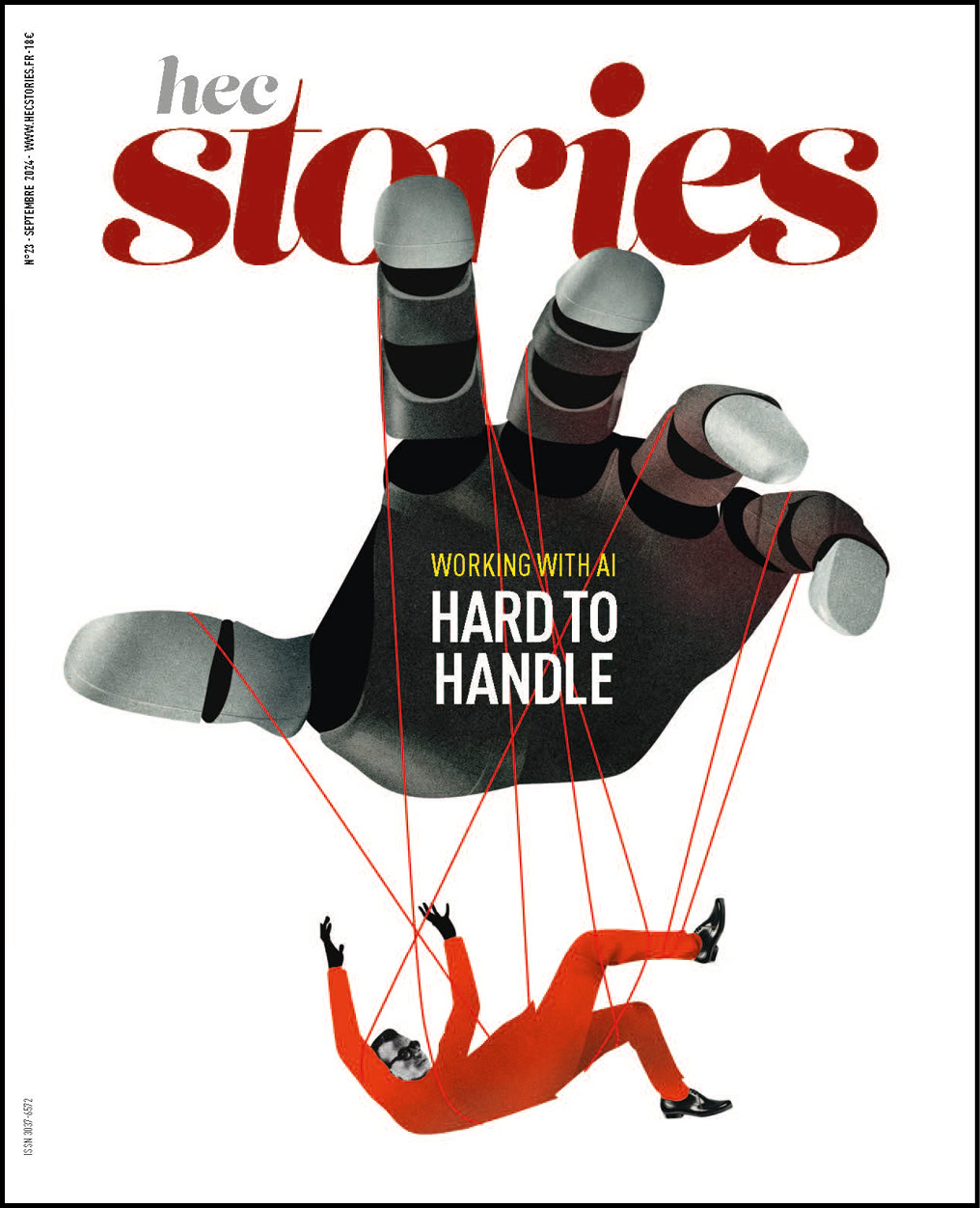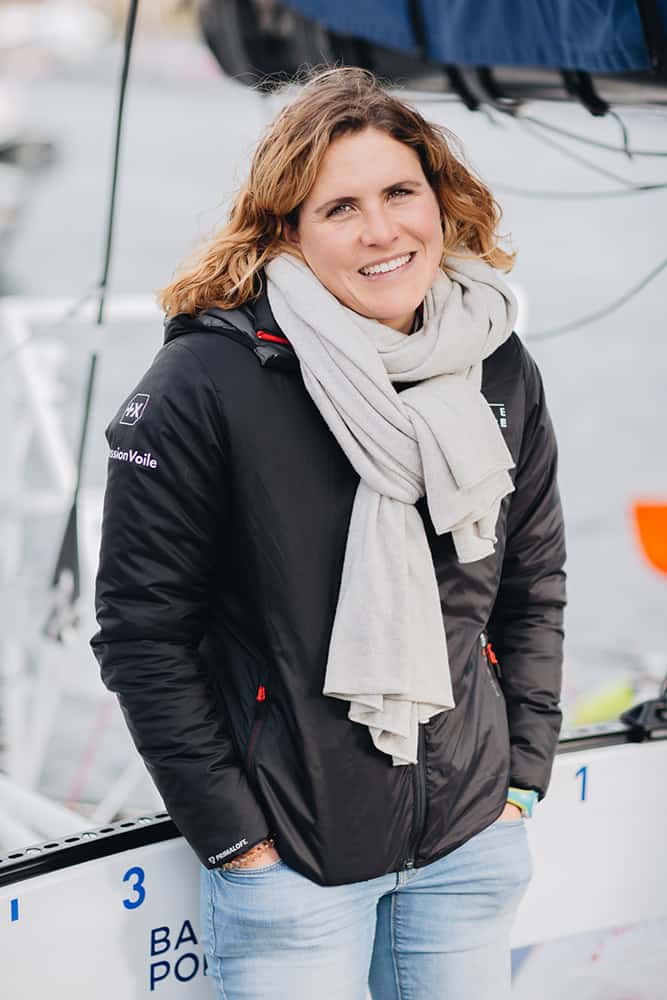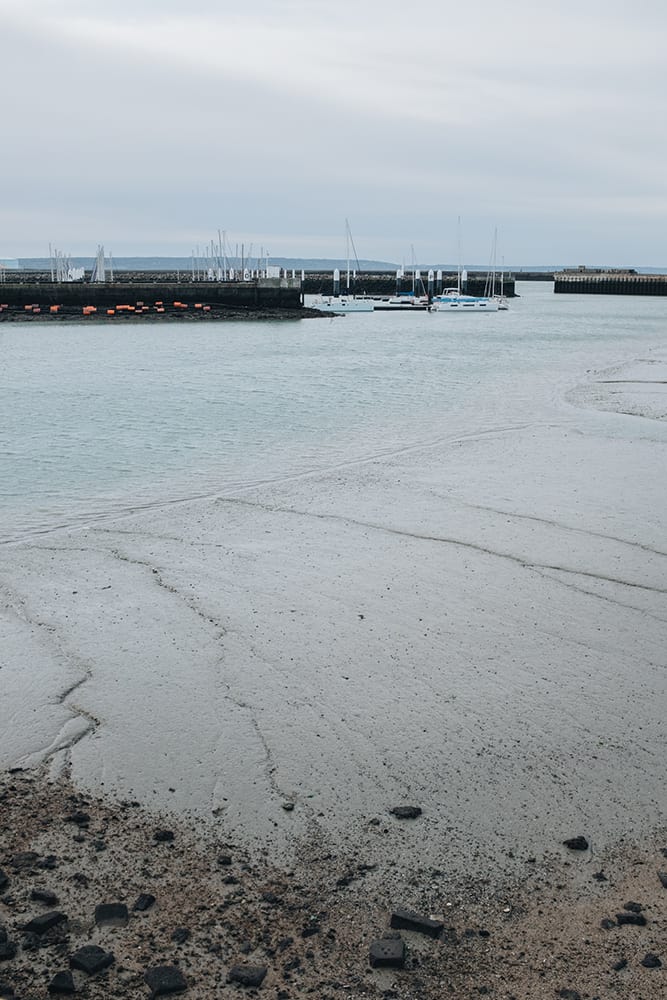24 hours with Clarisse Crémer (H.13)
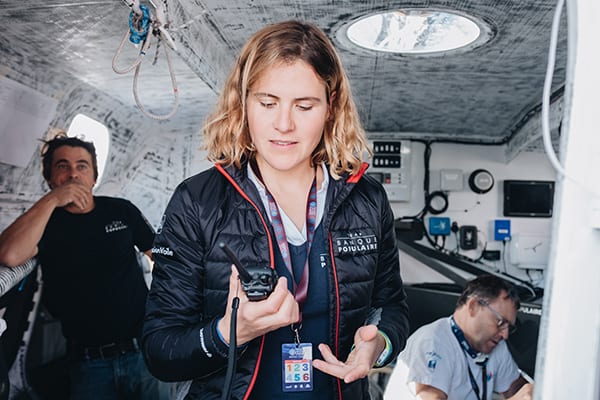
After earning her diploma from HEC in 2013, she quickly made a name for herself in the nautical world, and now she’s one of the top people in sailing. For one day, we dive into the daily life of a young skipper with wind in her sails.
Saved! For a while I thought a train strike would sink this report before it had even been launched, but I’ve docked safely at the right port: Le Havre. That’s where I’m to meet Clarisse, a young HEC graduate scheduled to set sail in a few days in the Transat Jacques-Vabre challenge.
9 AM, arrival in Le Havre
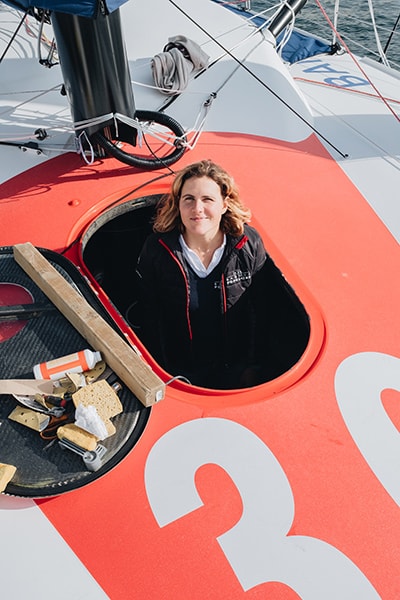
Late October. The sun is blinding in Le Havre and the wind is blowing so hard that it’s deafening. To get to the harbor in this sensory fog, we follow a trail of little coffee beans: flags in Jacques Vabre colors scattered around the port. Coffee is the theme of this great race inspired by major commercial shipping routes in the 18th century; this year it will link Le Havre and Salvador de Bahia, Brazil. The only transatlantic sailing race crossing from one hemisphere to another, it’s also one of the rare sailing competitions dominated by an HEC graduate, Jean-Pierre Dick (MBA.97), who won it four times. Clarisse is not yet at that point. Her participation in the Jacques Vabre will be her debut in an 18-meter IMOCA, the vessel ranked queen of this race. At 29 years old, she’s not exactly precocious (Ellen MacArthur, at that age, had already had a noteworthy career), but her story is one of the most atypical and phenomenal in the history of sailing. Phenomenal, because only five years ago Clarisse was a businesswoman who had never set foot on a racing boat. And atypical because she didn’t come to racing as part of a family of Breton sailors – she’s Parisian and the daughter of Christophe Crémer (H.76), founder of MeilleurTaux – or after an internship at the Glénans sailing school, but rather through a communications project!
It all began with a lively video meant to convince the brand Michel et Augustin to help her meet a crazy challenge: participate in a mini-transatlantic race. Even though the video fails to bring in a great deal of money, it’s a success, viewed more than 300,000 times. Building on this popularity, Clarisse starts to make more offbeat and funny little films about life on the waves. How do you put on makeup when you’re at sea? How to you get in shape for a transatlantic race? How do you use a “stand-up urinal” on a boat? All kinds of subjects covered with humor on her “Clarisse on the Atlantic” account. These original creations, combined with her performance as a skipper, soon attract sponsors’ interest, and she gradually builds up a strong reputation as a competitive sailor: first place in the mini-Fastnet, second place in the Mini-Transat in 2017, and 14th place in the Transat AG2R in 2018. But if anyone had told her that in 2019 she would be commissioned by Banque Populaire to sail an IMOCA along with Armel Le Cléac’h, she would never have believed it.
10 AM, port entrance
The solid blue “Banque Populaire X” is in fact right at the entrance of the port, making a place for itself among the colorful patchwork of its future rivals (La Mie Ca ̂line, Bureau Vallée, Yacht Club de Monaco…). As I lean on a railing, I’m not alone in checking out the boat. Next to me, a man in Bermuda shorts is watching people get off, and I realize from his Normandy flag covered with signatures that he’s an autograph-hunter and that he wants Clarisse’s – she’s already famous! And here she is, climbing over the railing with a smile, with her bags and a scooter (“Super practical for getting around the harbor”, she explains). The trip from Lorient has gone well, but she’s not yet used to this big boat. On board, she even got seasick (in nautical terms, she “fed the fish”), and now she just wants to rest. Especially since she has a full schedule ahead of her, including a media event at 11AM.
In fact, for the week before the race begins, sailors are required by their sponsors (it’s in their contracts) to be interviewed and have their pictures taken. And that’s what we will witness, this experience outside the norm for a skipper, devoted to storytelling and communicating. “In general I enjoy it, but after a while, after repeating the same things over and over, you begin to lose your authenticity,” she reveals. Her Google Agenda for the week has every minute scheduled by the Banque Populaire press attaché, who sets up the interviews. Clarisse goes to her hotel and I use this down time to explore the Transat “village”: a row of oilcloth-covered stands lined up all around the harbor. You can find a little of everything: Basque candies, someone selling binoculars, and even an inventor of a magnetic anti-snoring gadget. The quays, closed to the public, are almost deserted. Loudspeakers blast out a local radio program that vibrates all on its own in this sleepy little fair. There’s even a kind of market in the water, too. The innumerable logos covering all the boats give the blue concrete of the port an impressionistic air.
11 AM, media event
At 11, the waltz of the interviews begins. RTL opens the dance, on the bridge behind the boat. Is Clarisse ready? How will she and Armel Le Cléac’h share tasks? Will their partnership prove competitive against the best sailors? And Armel, is he a good teacher? Do you think more women should get involved in sailing? … The questions are almost always the same, no matter what the media is. Woven though it all is the story that Banque Populaire wanted to tell in bringing together two people with such different profiles. The contrast between the somber-eyed navigator and the brilliant young novice intrigues the press, and since the focus is on one passing along knowledge to the other, it almost seems like an initiation story. Used to all this, Armel Le Cléac’h answers questions calmly and professionally. Saving his energy, he manages a smile for the photos and that’s it. Clarisse, though, is open and giving. She engages in intelligent, friendly discussions with the journalists and appears to be sorry that she can’t give more to these interviewers who are so interested in her.
-
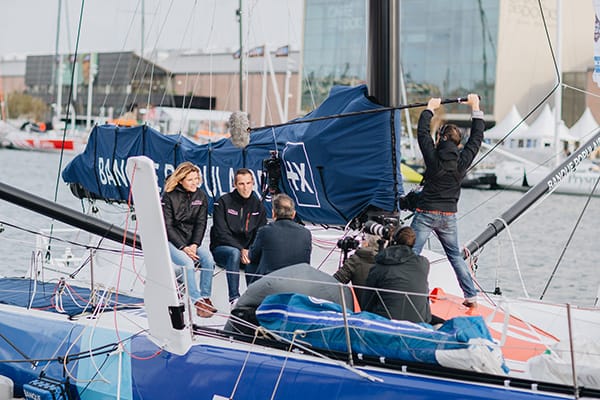
A succession of media representatives come onto the boat, all entranced by the Armel Le Cléac’h-Clarisse Crémer duo. -
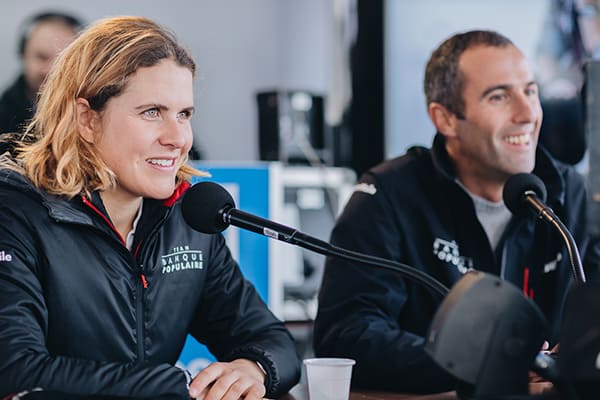
After three or four interviews, I slip away with her to the “skippers’ briefing”, which takes place on the Le Havre campus of Sciences Po. This little welcome session is a simple formality, but the race organizers use it to get across some useful messages in this week dedicated to communications. First of all, everyone is told (gently) to stop saying “Transat Jacques Vabre” and instead to say “Transat Jacques Vabre Normandie Le Havre”, since the region and the city are co-sponsors of the event. The skippers are also thanked for not referring to the race as simply a warm-up for the Vendée Globe. Clarisse must feel guilty when she hears this, because this is exactly how she and Armel have presented the race to the media. In fact, for them, the goal isn’t to win this race. In any case, winning it would be technologically impossible, because their boat, 10 years old, lacks foils. These attachments that make a boat look like it is flying over the water have totally changed things by allowing for speeds of almost 100 kilometers per hour. “The goal”, Clarisse explains, “is for me to get experience with an IMOCA and accumulate miles so that I can qualify for the Vendée Globe.” The solo race around the world is definitely an inspiration. For Clarisse, it will take her to a new level in her career. “A lot of sailors no worse than I am will never have the opportunity to participate in an adventure like this.” Or to follow in the wake of Armel Le Cléac’h, who set the course record (74 days) and won the last edition of the race.
1:30 PM, Café de la Métallurgie
The lunch menu is the same for Clarisse as for everyone on the Banque Populaire team: a roast drenched in camembert sauce with fries on the side. “Compared to other athletes, we can eat just about anything,” she explains. “In fact, the only thing we’re concerned about is the ratio of calories to weight, which should be as high as possible.” No surprise, since some sailors even cut off the handles of their toothbrushes to save a couple of ounces! Armel Le Cléac’h, in fact, hadn’t stocked quite enough for the Vendée Globe and ended up having to use his survival rations (“little blocks of grease that are pretty disgusting”) to finish the race. “Usually when we’re at sea, we eat freeze-dried or sterilized food. Cooking means pouring hot water into a bag.” The hardest daily challenge during a race, though, is getting enough sleep. When two people are making the transatlantic crossing, they can sleep in relays. When the sailor is alone, though, the rhythm is a lot tougher. “Not more than one hour of sleep per night, in segments of 10 minutes each, during the Solitaire du Figaro.” No wonder the unofficial motto of this race is “May the most awake win”. It becomes crucial to be aware of how lucid one is, but the danger threshold is quite high. “I can allow myself to have a few little hallucinations. If they’re short-lived and not too risky, it’s OK. On the other hand, one night I heard a voice calling for help on the port side. With my head lamp on, I searched the water for someone drowning before I realized that something wasn’t right and that it was only the wind. But the worst part of this was that five minutes later I had the same hallucination and I didn’t remember that I was doing the same thing all over again!”
3:30, Musto photo session

Clarisse and Armel are supposed to meet on the shore near the yacht port; they’re to take part in a photo session for the equipment brand Musto. “They’re the ones who make our waterproof suits. An amateur can wear one for five years with no problems. We go through dozens every year.” A complete suit costs around €5000. Other skippers are waiting for them for a group photo. Among them are legendary yachtsmen like Sam Davies from Britain and Jérémie Beyou from France. When we see them all together like this, we realize that their faces are a blessing for the photographers: their expressions weathered by salt air and maritime mists are in themselves an evocation of the ocean. It’s hard to see them as competitors. The adrenalin of competition is definitely there, though. “It’s the only thing that makes you get up after having slept for 10 minutes to raise a soaked sail in the middle of the night,” Clarisse insists.
Did she get this competitive spirit from HEC and her years as a businesswoman? Not really. “To tell the truth, I didn’t work very hard in my classes. Instead, I devoted myself to associations like Re ̂ve d’Enfance, the rugby club and of course the sailing association.” Her worst memory is from Carrefours HEC. “Unlike my friends, who saw this as a great opportunity, I was really uncomfortable at the thought of trying to sell myself and it even bothered me when a company showed interest in my CV.” On the other hand, her HEC experience has helped her in her relations with her sponsors. “The training taught me how to make good presentations and orderly balance sheets.” And how to manage her small enterprise. Her partnership with Banque Populaire is in the form of a commercial contract with her company “Clarisse on the Atlantic”. HEC also left her with a little physical souvenir: occasional pain in one foot from a rugby injury. A pity.
The Results
Clarisse Crémer and Armel Le Cléac’h finish the race in sixth place in the IMOCA category, after having been in second place for a while. An excellent result that ranks them first among boats with a straight centerboard. Tanguy le Turquais, after an excellent start that placed him number one in the Class40 category, had to abandon the race on the second day because of a broken mast.
5 PM, the “meter rule” and the e-prologue
We go back to the boat for the “meter rule”, a kind of required technical inspection. One of the many times Clarisse appreciates the convenience of working with a team. “Before, I had to be there for every part of the inspection, and I was the one who had to rush to stores to buy whatever was found to be missing.” Now, she only has to take care of one part of the process, and this time it’s to prove that the emergency telephone works. At the inspector’s request, she reaches for the “grab bag” in its storage place and takes out a portable phone that looks straight out of the 1990s. Then she only has to show that she’s able to make a call, and she manages this quite well…. Along with security requirements, satellite communications are now part of the event. “I have to make reports regularly, and we also organize Skype sessions for media. Sometimes when we’re exhausted, it’s not easy.” The inspection over, she rushes on her scooter to complete her last task of the day, the e-prologue. All the teams ready to set off on the Transat take part in a virtual competition, via tablet, that has been organized by a producer of video games who’s also a sponsor of the race. It’s pretty comical to see a bunch of old sea dogs directing their tiny boats with their fingers. One would expect Clarisse, representing generation Y, to come out ahead on the iPad. She finishes last.
Her partner Tanguy arrives then. He has also helped write Clarisse’s story. As though her adventure wasn’t already beautiful enough, it all began with a love affair. This young sailor is the main reason our champion got interested in sailing. It must seem strange to him to see her rise up in the ranks so quickly and reach a level above his own. She knows this, just as she knows that her history makes some people jealous. But she doesn’t worry about it. “In every field, what counts is to be in the right place at the right time. Banque Populaire wanted a woman who did not fit the same profile as Armel’s. For me, what matters now is to honor this chance that I’ve been given and to work hard to show that I deserve it.” Humility, diligence, talent… she clearly has everything it takes to sail far.
Published by Arthur Haimovici
